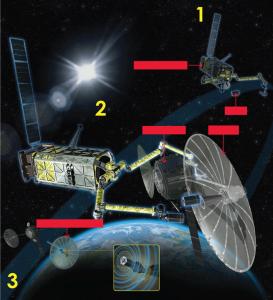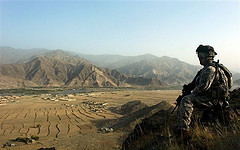Three incidents in areas in which the United States is active; one of the three may be the explosion of a long-buried land min. The lethality of land mines is no less than an IED or factory-produced munitions. One difference is that, because they’re clustered, more or less, in known areas, they’re easier to find, their relative age means that, however volatile, they don’t contain new technology and, if identified during demining operations, there’s at least the possibility of an information advantage. Plus robots, ground-penetrating radar, and other technologies. None of which makes a fraction of a difference in the absence of a commitment to clear mines in countries like Afghanistan.
From Afghanistan, Reuters via The New York Times:
Blast Kills 10 Afghan Girls Collecting Firewood – NYTimes.com – JALALABAD, Afghanistan (Reuters) – A blast killed 10 Afghan girls as they were collecting firewood in eastern Afghanistan on Monday, government officials said.
It was not immediately clear what caused the explosion in volatile Nangarhar province. It could have been a bomb planted by Taliban insurgents or a landmine left over from decades of conflict. The girls, between nine and 11 years old, were collecting wood in remote Chaparhar district, near the porous border with Pakistan, which is infested with some of the world’s most dangerous militant groups. “Unfortunately, 10 little girls were killed and two others wounded but we don’t know whether it was planted by the Taliban,” said Ahmadzia Abdulzai, provincial government spokesman. It was not immediately clear what caused the explosion in volatile Nangarhar province. It could have been a bomb planted by Taliban insurgents or a landmine left over from decades of conflict. The girls, between nine and 11 years old, were collecting wood in remote Chaparhar district, near the porous border with Pakistan, which is infested with some of the world’s most dangerous militant groups. “Unfortunately, 10 little girls were killed and two others wounded but we don’t know whether it was planted by the Taliban,” said Ahmadzia Abdulzai, provincial government spokesman.
Posted on the NYTimes.com website within an hour of the Reuters piece referenced above, Car Bomb Kills at Least 17 in Pakistan Tribal Region by Declan Walsh And Ihsanullah Tipu Mehsud. The headline – horrifying enough – understates matters. The piece in fact reports not one but two incidents, the second being the first “concerted attack” on the Peshawar airport. Excerpted from that piece:
Regarding the Car Bomb:
A powerful car bomb exploded near government offices in a town in the northwestern tribal belt on Monday, killing at least 17 people and wounding dozens, local officials said.
….
In Monday’s attack, officials said that a vehicle loaded with an estimated 90 pounds of explosives was detonated by remote control in Jamrud town, close to Peshawar, which borders the tribal belt. Although the blast occurred near the offices of a senior government official, its immediate force ripped through the women’s waiting area of a bus stop, said Jahangir Azim, a senior official in the Khyber agency. The dead included four Afghan woman and three children, he said. There was no immediate claim of responsibility for the blast, which damaged shops and vehicles across a wide radius. The dead and an estimated 44 wounded people were rushed to local hospitals.
The Airport attack:
“At the moment we are not in position to allege someone for the blast or to tell exactly what was the motive behind the attack by the perpetrators,” said Asmatullah Wazir, a local government official, by telephone. The Taliban attack against the Peshawar airport saw five militants die during a failed attempt to break through the airport perimeter wall on Saturday night, while another five died during a shootout with security forces at a nearby house on Sunday morning. At least five other people, including three civilians and two police, died in the attack, which marked the first concerted attack on the Peshawar airport. Although the Taliban claimed responsibility for that attack, officials identified several of the attackers as Uzbeks, suggesting that Al Qaeda-linked elements had also participated. Together, the two attacks killed at least 32 people and wounded more than 80, highlighting the challenges facing the security forces in the run-up to general elections that are due in the next six months.
Attack on Nearby House:
(Notice that the following quote is contained within the “airport attack” excerpt above). The Taliban attack against the Peshawar airport saw five militants die during a failed attempt to break through the airport perimeter wall on Saturday night, while another five died during a shootout with security forces at a nearby house on Sunday morning. (emphasis supplied).
Of these three attacks – we should keep in mind the possibility that they’re related – either as a show of the ability to coordinate multiple attacks, as a means of diverting resources and attention. That’s chilling, of course. And it’s hard to say which would be worse – one well-organized organization, or a community with many groups willing to shed blood, with no reservations about the blood of civilians, including noncombatant women and children.
Third, the Reuters report Bombs and Blasts Kill 11 in Iraq’s Disputed Areas, which was moved onto the New York Times website at 0453 Eastern time, describes at least 11 bombings and shootings over two days in the area in which Iraqi Kurdistan borders Iraq proper. It’s probably safe to say that the combined resources of Reuters, the Times, and the Washington Post in Iraq don’t permit covering a dozen incidents at the same time in any detail.
It seems to us fairly obvious that the international community, including the United States, ought to try to brokera deal which protects the Kurds’ interests – since the only thing all of their neighbors have in common is antipathy towards the Kurds and a commitment to deny them a homeland. The other inferences we draw from this slice of recent events are that things aren’t improving in Iraq, Afghanistan or Pakista; that things are likely to worsen with the departure of United States forces; and that are likely to worsen even if United States and NATO forces were, tomorrow, to radically increase military and civil assistance.
There is one set of steps we could take, at relatively low cost: address the matter of land mines in Afghanistan:
- Continue funding research into safe technologies for detecting and making safe land mines, including controlled detonations; we might find that, with some adaptations, our UAV (“Unmanned Aerial Vehicle,” or “drone”) technologies, may lend themselves to precisely targeting minefields and use the drones’ munitions to “cook off” the buried ordnance – with, of course, the permission and cooperation of local communities
- If we can’t eliminate them in the near term, our armed forces – with the assistance of NGOs and contractors – could mark and fence off minefields, essentially child-proofing them. Where minefields block critical routes, we can do both: clear a path sufficient for vehicle, farm equipment, animal, or pedestrian passage, and secure the uncleared portion of the area.
- If Afghani children are risking death to collect firewood, we can, as we plan our exit from Afghanistan, use our military and civilian engineers to make it unnecessary for children to die or be maimed because of Afghanistan’s energy poverty. What can we do?
- Help communities insulate housing with available materials, from the environment and using discarded materials. For instance, walls built with automobile tires filled with dirt have been used to construct sturdy, highly insulated and wind resistant-walls;
- Solar ovens are inexpensive, can be built with scrap metals, and permit cooking with little or no wood;
- There are a variety of systems – again, relatively low-tech – which convert solar energy to heat and/or hot water;
- Photovoltaic solar panels and low-speed wind turbines can provide enough energy for the essentials: light, refrigeration, and wireless communications. This means we can help Afghanis build a telecommunications and Internet infrastructure with reasonable bandwidth; the cost of digging trenches and burying fiber-optic cable – except perhaps in major cities – is an excuse for inaction. Giving Afghanis an information infrastructure makes possible distance learning and telemedicine (think remote diagnostics with general practitioners and specialists).
- The proposals above are, or should be- non-controversial. Our final proposal we make knowing that it will disturb many, but with the certainty that it is the least worst of available options: take steps to wards the decriminalization of opiates. The illicit market in opiates has, at different times, financed the Taliban (who were clever enough to ban small-scale opium growers in order to force the price upwards), various warlords whose allegiances are, at best, available only for short-term rental, and made great fortunes for Pakistani military and intelligence officers, and well-connected members of Pakistan’s political elites. None of these men – and, apparently, they are all men – are allies of the United States. Nor do they have the welfare of Pakistani or Afghani citizens in mind. These are, for want of a more sophisticated phrase, the bad guys. Let’s do to them now what we did to the Mob when we ended Prohibition in 1933: take away their primary source of income.
Then, when we need the cooperation of a Pakistani official or an Afghan warlord, they may still be corrupt, but we’ll have reduced the likelihood that they’re already taking money from the Taliban, for whom opium revenues were and are unrivalled, even by the fortunes of Osama bin Laden before his family and the Saudi government cut off access to his trust fund income (if not “trust funds” in the narrow Western legal meaning, Osama was still, even with many brothers, a beneficiary of one of the largest estates or bequests in Saudi Arabia, larger than the estates of many Saudi royals).
Even if we have to buy opium to keep it off the market – we need to stop the big-time drug dealers – who, like their distant cousins in Mexico – are dependent on the illegal status of drugs and its corollary – fantastically high prices for an agricultural commodity.
We’ve cut the head off of every Al-Qaeda member who’s taken the top operational spot. Let’s take away their money, too. Bin Laden couldn’t have hid in Abbottabad for so long without lots of money to buy land, build a house with high walls, and finance the travel expenses of a network of couriers. Front companies, office rent, disposable mobile phones, buying and renting lots of vehicles, bribing the odd official – running a covert operation is pricey.
So – if we’re going to leave Afghanistan – let’s leave the citizenry safer and healthier – and take the drug money away from the bad guys on our way out.
xxx





